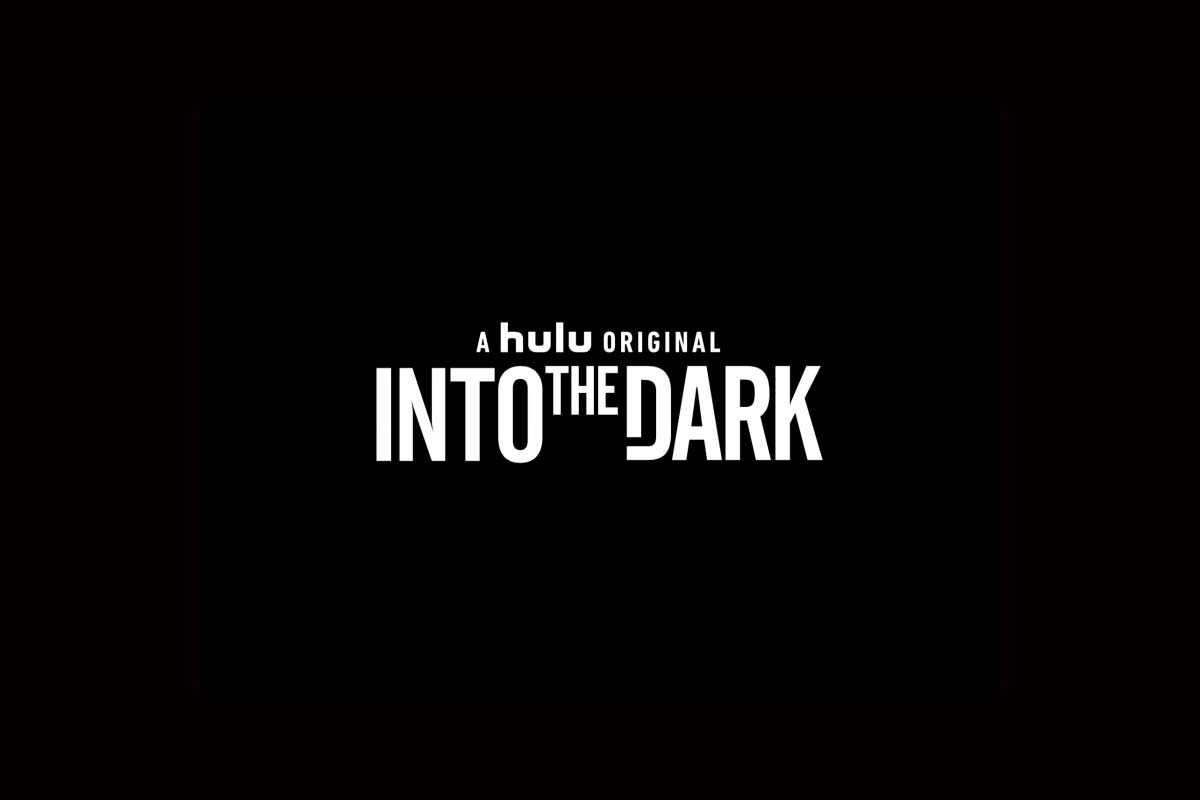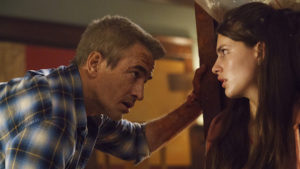
INTO THE DARK
EPISODE 2 – FLESH & BLOOD
 Starring: Dermot Mulroney, Diana Silvers, Tembi Locke
Starring: Dermot Mulroney, Diana Silvers, Tembi Locke
Director: Patrick Lussier
Writers: Louis Ackerman
Reviewed by Sidney Morgan
This review CONTAINS MINOR SPOILERS.
Into the Dark, a Blumhouse Television Production miniseries available on Hulu just released its second episode. Recall that not only would there be a horror element in these monthly episodes, but each one would be inspired by a different holiday. Its premiere episode The Body, which aired at the beginning of October, was set on Halloween night. So it isn’t surprising that this second and November entry, Flesh & Blood, is inspired by Thanksgiving. But don’t expect a happy celebration as the episode features the story of a father and daughter who try to come to terms with the death of their spouse/mother from a year earlier. It’s difficult because it wasn’t an ordinary death. In fact, she was brutally murdered, and there’s no closure on the horizon as the killer hasn’t been found yet.
Kimberly (Diana Silvers) has some serious issues, but the death of her mother (Meredith Salenger) made it all worse. The most crippling though is her agoraphobia. Whenever Kim tries to leave the house, as soon as she crosses the threshold of the front door, she becomes disoriented and freezes. The director tries to convey her feelings to viewers by shaking the camera, blurring the edges of the scene, and having us hear loud noises. The effects aren’t overly original, but they work. And for the purposes of the episode, the agoraphobia is perfect. Kim’s inability to get out confines the action to the house.

It’s a really nice house and looks perfect. Well almost. So why is dad doing needless, yet ongoing renovations? Is it perhaps to excuse any irregularities that could be found? In any case, for something that plays such an important role in the episode, the house never really feels creepy, scary or even claustrophobic. As the story unfolds, and considering it’s a horror (or should at the very least be a thriller), the house needed to be fleshed out more. It felt like a prop, like any other house when it should have been giving off a sense of foreboding and dread. It is, after all, a house that holds secrets.
Given there are so few characters in the episode, the good performances turned out to be an asset. Diana Silvers does a great job giving life to the psychologically frozen teen, unable to move on from the events surrounding her mother’s death. Her interactions with her on-screen father and her therapist help her character develop from a lost, confused teen to an astute, willing-to-face-her-fears one. However, and this is more a criticism of the writing, the way she begins to suspect her father was borderline ridiculous. After receiving a necklace from him, she happens to notice the same necklace around a missing girl’s neck on television. And that becomes the main reason for her to become suspicious of her father. Really? Sure she keeps hearing him skulking around in the attic and wonders about the drugs he makes her take, but this turning point felt contrived.

Dermot Mulroney also gives a great performance as Henry, Kimberly’s father. Even though he’s a suspicious character from the early going, his slow journey to revealing his true self was interesting. I still see him as the charming ex-boyfriend about to get married in My Best Friend’s Wedding, or as the hopeless romantic one in the recent Homecoming. Heck, even in I Still See You, he’s too charming to come across as bad. He’s got a calm demeanor and a face that oozes kindness, innocence, and trust. But it’s exactly what makes his transformation into madness that much more impressive. However, once again, the writing let the actor down.
Given the story, it wasn’t going to be easy building up the relationship between father and daughter, only to have it deteriorate. And for the most part, it worked. Mulroney’s facial expressions are convincing, and most of the interactions between the two grow in intensity. However, how many times did we have to hear him say that everything he did, he did out of love for Kimberly? Given how the story evolved and the context, it was a misplaced sentiment and eventually, lacked the emotional fuel it should have had.
As with its first entry, Flesh & Blood drags out the action for too long. It’s advertised as a television series, yet it insists (at least so far) on each entry having a ninety minute running time, usually a length associated with movies. And repetition of the same actions doesn’t make a movie. After we meet the characters and the main conflict is exposed, it’s Kimberly trying to escape. Kimberly freezes from her agoraphobia, Henry getting the upper hand, and then, it’s all repeated. It was a much better story than The Body, but it could have been shorter. This would have increased the tension and the suspense. As it is, it’s equally frustrating as it is entertaining.

Too many of the scenes felt contrived. Like Kimberly coincidentally noticing her necklace is the same as the missing girls, tarnished spots included. Who notices that kind of stuff? Furthermore, was anyone surprised when the note gets stuck at the bottom of the teacup, falling to the floor and then sticking to Dr. Saunders’ shoe? Or when Kimberly’s foot crashes through the floor of the attic? But the greatest plot hole was that with all those neighbors, all that access to electronic devices, Kimberly couldn’t get anyone to help her? She’s agoraphobic, not a mute. The story is good, but the writing is going to have to get tighter if this anthology is to succeed.
One aspect of the story, which was teased yet not fully developed, was Kim’s mental state. There is no doubt that she is suffering and it’s debilitating. Her sessions with Dr. Saunders (Tembi Locke) highlight the issues but do little to delve in them. I rolled my eyes when the good doctor suggested that Henry watch his daughter for signs of repressed feelings or the potential for violent outbursts. It gave Henry the ammunition he needed to mess with her and confuse her. At times, it was unclear if she was mentally unstable or the victim of the medication’s influence. It’s part of the story that could have helped with the suspense, but the opportunity was missed.
Verdict
Flesh & Blood is a good story (much better than episode one) that suffers from being stretched out. The interactions between Kim and Henry were interesting, leading to a psychological battle that is worth watching, even though the outcome is predictable. With the mystery solvable early on, the director fails to build on the suspense to make this a horror or even a thriller. Repeating the same thing didn’t make it better. In fact, it makes the story frustrating at times. Nonetheless, Dermot Mulroney and Diana Silvers perform really well, given a 90-minute story in which they’re basically the only two actors.
However, the biggest disappointment is, as it was in the first episode, that Flesh & Blood has nothing to do with Thanksgiving. It’s an afterthought. It could have been Easter, Christmas or any random weekday and it would have been the same. Yet, the series is advertised as being horror tales inspired by various holidays. That really hasn’t been the case yet. Maybe the third time will be a charm and next month’s Christmas entry will be, well, inspired by Christmas. In the meantime, despite its flaws, Flesh & Blood is a good entry and worth a watch.



